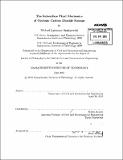The subsurface fluid mechanics of geologic carbon dioxide storage
Author(s)
Szulczewski, Michael Lawrence
DownloadFull printable version (18.35Mb)
Other Contributors
Massachusetts Institute of Technology. Department of Civil and Environmental Engineering.
Advisor
Ruben Juanes.
Terms of use
Metadata
Show full item recordAbstract
In carbon capture and storage (CCS), CO₂ is captured at power plants and then injected into deep geologic reservoirs for long-term storage. While CCS may be critical for the continued use of fossil fuels in a carbon-constrained world, the subsurface behavior of CO₂ remains poorly understood, which has contributed to the absence of government policy to implement CCS. In this Thesis, we use simulations, experiments, and theory to clarify the fluid mechanics of CO₂ storage, with the goal of informing two practical questions. The first question is, how much CO₂ can be stored in the United States? This question is important to clarify the role of CCS among the portfolio of other climate-change mitigation options, such as renewable energy and reduced energy consumption. To address this question, we develop models of CO₂ injection and the post-injection migration, and apply them to several reservoirs in the US. We use the models to calculate the total amount of CO₂ that can be stored in these reservoirs without hydraulically fracturing the caprock or allowing the CO₂ to migrate to a major leakage pathway. We find that the US has sufficient storage capacity to stabilize emissions at the current rates for at least 100 years. The second question is, what are the long-term dissolution rates of CO₂ into the ambient groundwater? This question is important because dissolution mitigates the risk of CO₂ leakage to shallower formations or the surface. We address this question for storage in structural and stratigraphic traps, which are promising locations in a reservoir for injection and will likely be the first sites of large-scale CCS deployment. We describe several mechanisms of CO₂ dissolution in these traps and develop models to predict the dissolution rates. We apply the models to relevant subsurface conditions and find that dissolution rates vary widely depending on the reservoir properties, but that thick reservoirs with high permeabilities could potentially dissolve hundreds of megatons of CO₂ in tens of years.
Description
Thesis (Ph. D.)--Massachusetts Institute of Technology, Department of Civil and Environmental Engineering, 2013. Cataloged from PDF version of thesis. Includes bibliographical references (pages 157-168).
Date issued
2013Department
Massachusetts Institute of Technology. Department of Civil and Environmental EngineeringPublisher
Massachusetts Institute of Technology
Keywords
Civil and Environmental Engineering.